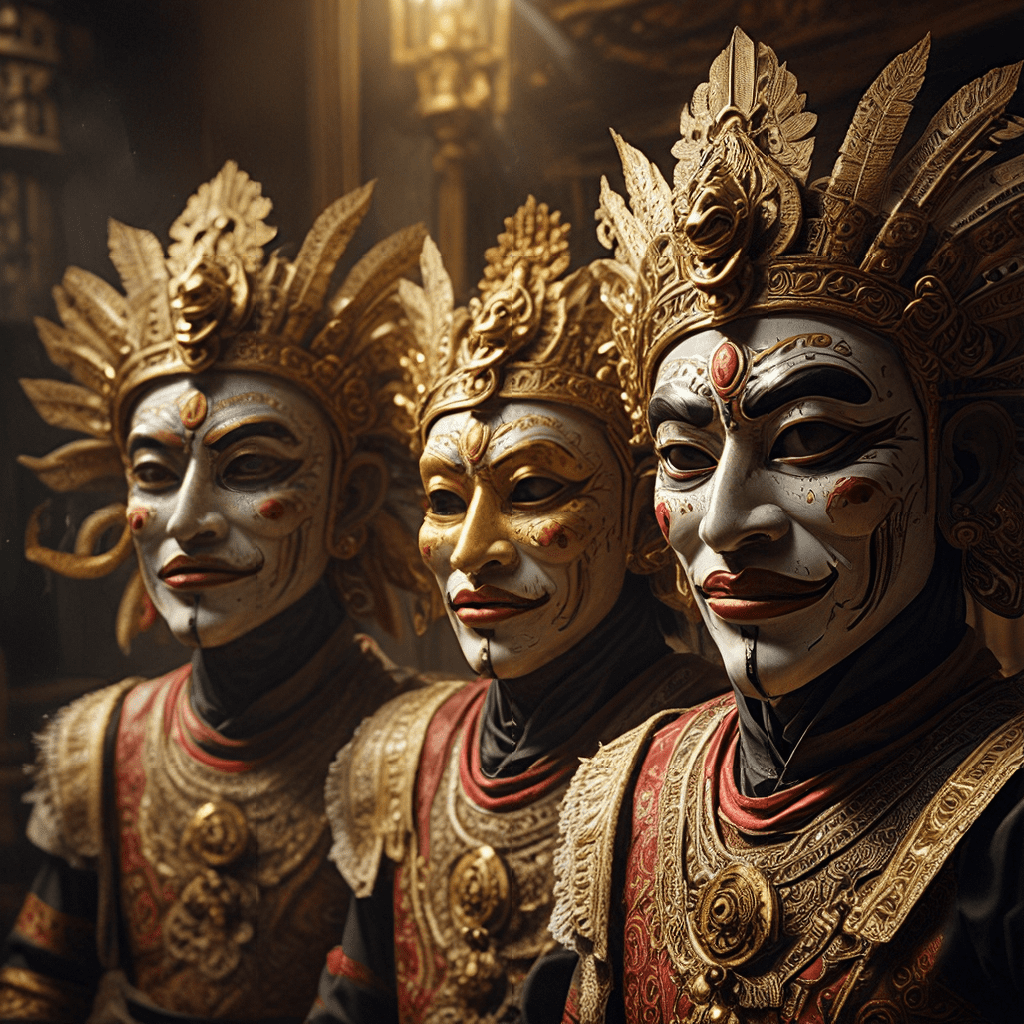Filipino Mythology: Tales of Sacrifice and Redemption
Dive into the captivating world of Filipino mythology, where spirits dance among mortals, and ancient stories echo with powerful lessons about sacrifice and redemption. This rich tapestry of legends offers a glimpse into the beliefs and values that have shaped Filipino culture for centuries.
Introduction: A World of Spirits and Legends
From the bustling city streets to the tranquil rice paddies, the Philippines is a land where ancient tales and mystical beings intertwine with modern life. The archipelago's diverse landscape, from towering mountains to sparkling seas, has inspired countless stories about deities, heroes, and creatures both benevolent and malevolent. Within these myths, we encounter a deep-rooted belief in the power of sacrifice, a theme that resonates throughout Filipino folklore.
The Central Role of Sacrifice in Filipino Mythology
Sacrifice, in its various forms, is woven into the very fabric of Filipino mythology. It often serves as a bridge between the human and spiritual realms, a way to appease the gods, honor ancestors, or ensure harmony in the natural world. This concept of sacrifice is not simply about giving something up; it signifies a profound act of selflessness, a willingness to endure hardship for the greater good.
The Divine Sacrifice of Bathala: A Foundation for Redemption
Bathala, the supreme deity in Filipino mythology, embodies the ultimate sacrifice. He created the world and its inhabitants, but his act of creation also entailed a profound sacrifice. According to legend, Bathala poured his own lifeblood into the earth to give it life, demonstrating the selfless nature of divinity. This creation myth underscores the importance of sacrifice as a foundation for existence and the possibility of redemption.
The Myth of Lam-Ang: A Journey of Sacrifice and Rebirth
One of the most beloved Filipino folktales, the myth of Lam-Ang, tells the story of a valiant warrior who embarks on a perilous journey to find a cure for his love, Ines, who has died. To bring her back to life, Lam-Ang faces countless challenges, including battling monstrous creatures and making difficult choices. He sacrifices his own desires and risks his life for love, ultimately achieving redemption by bringing Ines back from the dead. His story symbolizes the transformative power of sacrifice and the possibility of rebirth through love and selflessness.
The Story of Maria Makiling: Redemption Through Nature’s Grace
The legend of Maria Makiling is a testament to the interconnectedness of humanity and nature. Maria Makiling, a beautiful spirit who dwells in Mount Makiling, is a protector of the forest and its inhabitants. She embodies the spirit of the mountain and rewards those who respect nature and protect the environment. Those who mistreat the forest or harm its creatures face Maria Makiling's wrath, highlighting the need for ethical behavior towards the natural world.
The Legend of the Aswang: Moral Redemption Through Courage and Sacrifice
The Aswang, a terrifying creature of Filipino folklore, represents the darker side of human nature. They are shape-shifting beings, often depicted as witches who feast on human flesh. However, within the stories of the Aswang, we find themes of courage, sacrifice, and the possibility of moral redemption.
While often feared, the Aswang is also a reminder of the fragility of human life and the challenges we face in overcoming our darkest impulses. Many tales highlight the courage of individuals who face the Aswang, often risking their lives to protect their communities. Their sacrifice serves as a beacon of hope, reminding us that even in the face of darkness, humanity can prevail through bravery and selflessness.
The Role of Ancestors and Spirits in Redemption
In Filipino mythology, the spirits of ancestors play a vital role in the lives of the living. They are believed to watch over their descendants, offering guidance, protection, and even punishment if their wishes are not respected. Redemption, in this context, often involves seeking forgiveness from ancestors for transgressions against their memory or for failing to uphold family traditions.
Through rituals, offerings, and prayers, Filipinos honor their ancestors and seek their blessings. This connection to the spirits of the departed reinforces the importance of community, family, and the legacy we leave behind. It reminds us that our actions have consequences, not only in this life but also in the spirit world.
Theories of Sacrifice and Redemption in Filipino Mythology
Filipino mythology offers a rich tapestry of beliefs and interpretations, and the concept of sacrifice and redemption has been analyzed through various lenses. Some scholars suggest that these themes reflect the hardships faced by Filipino communities and their resilience in the face of adversity.
The constant struggle against natural disasters, poverty, and societal injustices may have influenced the development of stories that emphasize the importance of sacrifice and the possibility of finding hope in the midst of challenges. Others believe that the concept of sacrifice is rooted in the animistic beliefs of the indigenous Filipinos, who revered nature and sought to appease the spirits through offerings and rituals.
The Impact of Spanish Colonization on Filipino Beliefs
The arrival of the Spanish in the Philippines brought with it a new set of religious beliefs and practices. Catholicism, with its emphasis on the sacrifice of Christ, had a profound impact on Filipino culture. However, many traditional beliefs and practices have persisted, blending with the new religious influences.
The concept of sacrifice has remained central to both Filipino mythology and Catholicism, but its interpretation and expression have evolved. While Catholic beliefs emphasize the sacrifice of Christ as a means of seeking redemption for humanity's sins, Filipino mythology offers a broader perspective on sacrifice as an act that can be performed by individuals, communities, or even deities.
The Contemporary Relevance of Filipino Mythology: Lessons for Modern Life
Despite the changing times, Filipino mythology continues to resonate with contemporary audiences. Its themes of sacrifice, redemption, and the interconnectedness of humanity and nature offer valuable lessons for modern life. The stories of the Aswang, Lam-Ang, Maria Makiling, and other mythical figures serve as reminders of the importance of courage, compassion, and respect for our fellow human beings and the natural world.
In a world often characterized by moral ambiguity, Filipino mythology provides a framework for understanding our own complexities and the consequences of our actions. It reminds us that even in the face of adversity, there is always hope for redemption, and that our choices have the power to shape both our individual lives and the world around us.
Frequently Asked Questions:
Q: What are some other important deities in Filipino mythology aside from Bathala?
**A: ** Some other important deities include:
- Lalahon: Goddess of fertility and the harvest.
- Mayari: Goddess of the moon and the hunt.
- Agni: God of fire.
- Sigbin: A nocturnal creature believed to be a shapeshifter.
- Kapre: A giant, cigar-smoking tree spirit.
Q: How does Filipino mythology differ from other mythologies around the world?
A: Filipino mythology shares some similarities with other mythologies, such as the importance of nature spirits and the concept of the afterlife. However, it also has unique features, including its focus on the role of ancestors and the importance of sacrifice in maintaining harmony between the human and spirit realms.
Q: What is the significance of the use of animals and plants in Filipino mythology?
A: Animals and plants play a significant role in Filipino mythology, often representing specific virtues or vices. For example, the monkey is associated with mischief and cunning, while the eagle is a symbol of strength and courage.
Q: Are there any contemporary Filipino writers who draw inspiration from Filipino mythology?
A: Yes, there are many contemporary Filipino writers who are inspired by Filipino mythology. Some examples include:
- Nick Joaquin: Known for his novels and short stories that explore Filipino history and mythology.
- F. Sionil Jose: Known for his novels, including "The Rosales Saga," which weave together themes of Filipino culture, history, and mythology.
- Michael Ondaatje: Although born in Sri Lanka, his novel "The English Patient" incorporates themes of Filipino mythology.
Q: Where can I learn more about Filipino mythology?
A: There are numerous resources available online and in libraries about Filipino mythology. You can also find books, articles, and documentaries that explore the rich tapestry of Filipino folklore.



